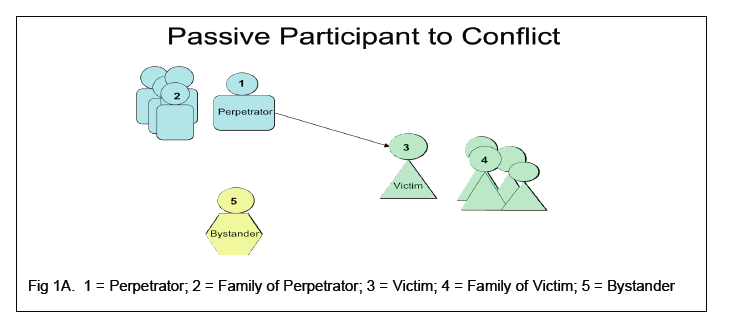Passive Participation in Conflict submit to War, Reconciliation and Healing [Main Post with PDF]
Personal Reflection on Passive Participation in Conflict
Background: Why consider Passive Participants in a Conflict? [2 of 12]
Personal Reflection on Passive Participation in Conflict
Background: Why consider Passive Participants in a Conflict? [2 of 12]
Passive Participation in Conflict: A Framework for Reclaiming Wholeness
The aim of this paper is to open paths to healing emotional injuries stemming from conflict and oppression. By expanding awareness of the ripple effects of conflict, we may better identify the injuries that occur often among passive participants in conflicts. Passive participants, like the obvious victims of conflict, may suffer from their experience in the conflict. The paper offers a framework to transform this suffering and thus reclaim wholeness in ourselves, in our communities, and in the world. This is a developing perspective;[1] I invite reflections, suggestions, and experiences.[2] I offer this paper with the hope that it inspires further inquiry and dialogue.
I. Expanding Awareness: Who are Passive Participants in a Conflict?
One day, I notice a neighborhood cat with a mouse between its paws. The well-fed cat doesn’t need a mouse for food, it chases the mouse from instinct. I bang on the window startling the cat, the wounded mouse flees, but realizing no real threat, the cat recaptures the mouse. As the cat walks away with the limp mouse in its mouth, the cat glances back at me. Understanding this is how nature is, I weep for the cat in all of us who without awareness and without remorse creates unnecessary suffering for others less powerful, and I weep for the mouse in all of us who experiences fear and suffering from these unconscious acts of others. Days later, I see this cat chasing a new mouse, I intervene spraying a hose not at the cat but in its vicinity hoping to distract the cat sufficiently. Fearful of the water, the cat drops the bloodied mouse, who scurries to safety. The cat looks at me, perhaps bewildered that I interrupted its activities, perhaps angry that I stopped its play, then skulks away, knowing it lost the mouse, and not understanding what has happened. I realize in that moment, to the cat I have been an aggressor. I weep for the lack of understanding, and for the part of our nature that instinctively drives us to acts that create suffering for others. I wonder, how can we, as bystanders or passive participants in conflict, break cycles of violence without becoming a participant anew to the cycle?
This figure shows some of the participants whose experience of a conflict may require healing. (Figure 1A). There is a perpetrator and a victim. In addition, their families and a bystander are passive participants to the event.
Most post-conflict healing focuses on the victim and the perpetrator. However, this paper identifies others who have a lesser or no apparent involvement in the conflict, and considers whether they also may suffer injurious experiences that require attention. Often people in these ‘passive’ roles may not recognize an injury or may not even perceive their involvement. Particularly in conflict where the active injury is extreme, it dwarfs these passive experiences. A bystander with unhealed injuries from prior conflict may lead to inappropriate actions (e.g. use of power in ways that perpetuate inequities). These actions may result in more violence, often a cyclical phenomenon, perpetuated through generations.
When we heal our experiences, we reclaim our wholeness. In wholeness, we are aware of our power, share our power with ease, and learn to use our power well. This paper posits that acknowledging these passive experiences in conflict may provide a path to heal, to reclaim our wholeness, and to allow transformative change – ultimately to end cycles of violence.
When we heal our experiences, we reclaim our wholeness. In wholeness, we are aware of our power, share our power with ease, and learn to use our power well. This paper posits that acknowledging these passive experiences in conflict may provide a path to heal, to reclaim our wholeness, and to allow transformative change – ultimately to end cycles of violence.
[1] This work draws upon the practices of Buddhism applying them to reconciliation and healing. I am student of all these disciplines, and I make no pretense of being a master of any of these fields. This paper leaves me with more questions than answers, and I humbly offer this framework with the hope that it will stimulate others to study this area and that others’ input will further inform my work in healing conflict, building capacity, and promoting social justice.
[2] Please contact the author via Twitter @katemural or via "Say Hi" under Home Tab



 RSS Feed
RSS Feed